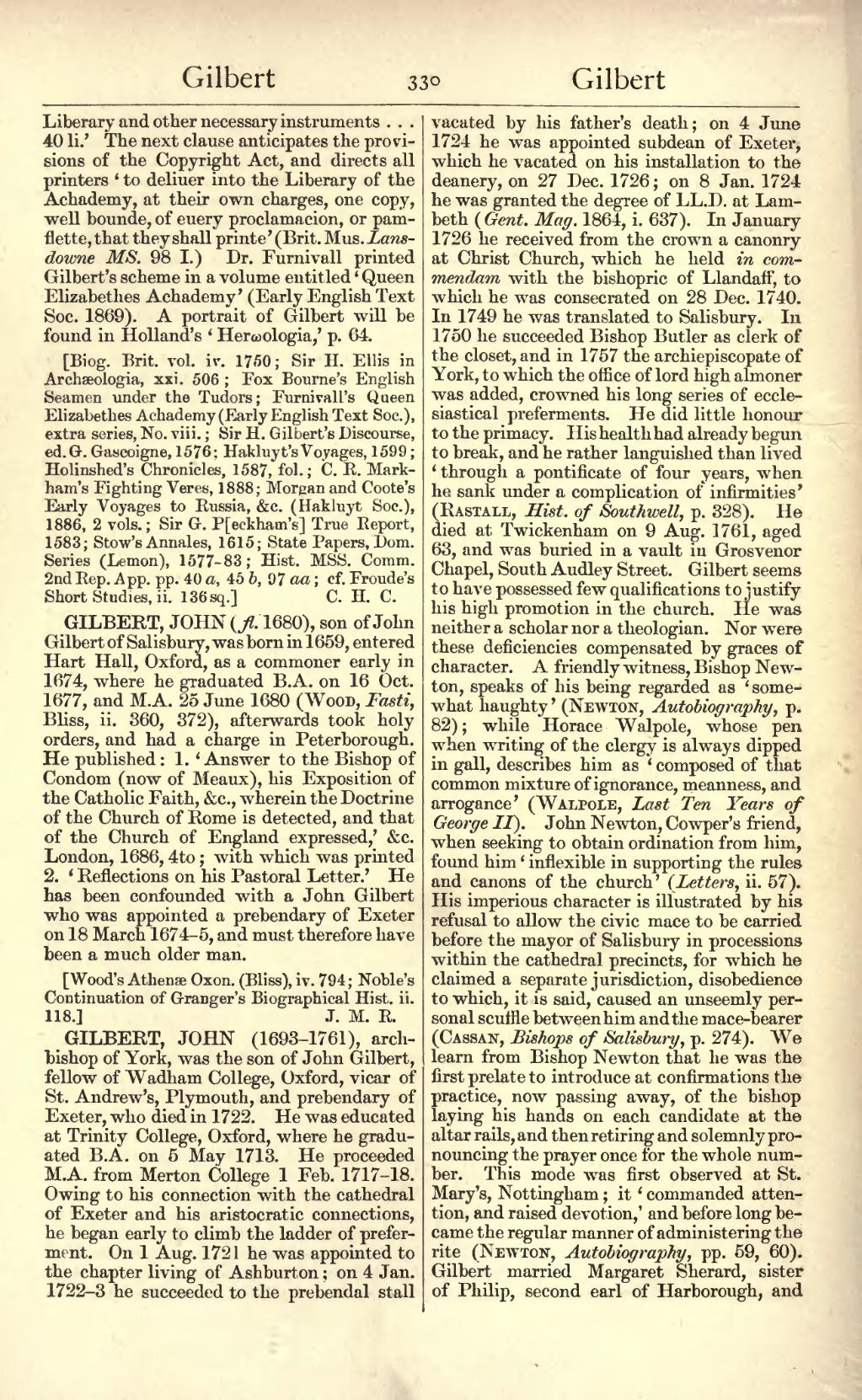Liberary and other necessary instruments … 40 li.’ The next clause anticipates the provisions of the Copyright Act, and directs all printers ‘to deliuer into the Liberary of the Achademy, at their own charges, one copy, well bounde, of euery proclamacion, or pamflette, that they shall printe’ (Brit. Mus. Lansdowne MS. 98 I.). Dr. Furnivall printed Gilbert's scheme in a volume entitled ‘Queen Elizabethes Achademy’ (Early English Text Soc. 1869). A portrait of Gilbert will be found in Holland's ‘Herωologia,’ p. 64.
[Biog. Brit. vol. iv. 1750; Sir H. Ellis in Archæologia, xxi. 506; Fox Bourne's English Seamen under the Tudors; Furnivall's Queen Elizabethes Achademy (Early English Text Soc.), extra series, No. viii.; Sir H. Gilbert's Discourse, ed. G. Gascoigne, 1576; Hakluyt's Voyages, 1599; Holinshed's Chronicles, 1587, fol.; C. R. Markham's Fighting Veres, 1888; Morgan and Coote's Early Voyages to Russia, &c. (Hakluyt Soc.), 1886, 2 vols.; Sir G. P[eckham's] True Report, 1583; Stow's Annales, 1615; State Papers, Dom. Series (Lemon), 1577–83; Hist. MSS. Comm. 2nd Rep. App. pp. 40 a, 45 b, 97 aa; cf. Froude's Short Studies, ii. 136 sq.]
GILBERT, JOHN (fl. 1680), son of John Gilbert of Salisbury, was born in 1659, entered Hart Hall, Oxford, as a commoner early in 1674, where he graduated B.A. on 16 Oct. 1677, and M.A. 25 June 1680 (Wood, Fasti, Bliss, ii. 360, 372), afterwards took holy orders, and was vicar of St. John Baptist's Church, Peterborough. He published:
- ‘Answer to the Bishop of Condom (now of Meaux), his Exposition of the Catholic Faith, &c., wherein the Doctrine of the Church of Rome is detected, and that of the Church of England expressed,’ &c. London, 1686, 4to; with which was printed.
- ‘Reflections on his Pastoral Letter.’ He has been confounded with an older John Gilbert who was appointed a prebendary of Exeter on 18 March 1674–5.
[Wood's Athenæ Oxon. (Bliss), iv. 794; Noble's Continuation of Granger's Biographical Hist. ii. 118.]
GILBERT, JOHN (1693–1761), archbishop of York, was the son of John Gilbert, fellow of Wadham College, Oxford, vicar of St. Andrew's, Plymouth, and prebendary of Exeter, who died in 1722. He was educated at Trinity College, Oxford, where he graduated B.A. on 5 May 1713. He proceeded M.A. from Merton College 1 Feb. 1717–18. Owing to his connection with the cathedral of Exeter and his aristocratic connections, he began early to climb the ladder of preferment. On 1 Aug. 1721 he was appointed to the chapter living of Ashburton; on 4 Jan. 1722–3 he succeeded to the prebendal stall vacated by his father's death; on 4 June 1724 he was appointed subdean of Exeter, which he vacated on his installation to the deanery, on 27 Dec. 1726; on 8 Jan. 1724 he was granted the degree of LL.D. at Lambeth (Gent. Mag. 1864, i. 637). In January 1726 he received from the crown a canonry at Christ Church, which he held in commendam with the bishopric of Llandaff, to which he was consecrated on 28 Dec. 1740. In 1749 he was translated to Salisbury. In 1750 he succeeded Bishop Butler as clerk of the closet, and in 1757 the archiepiscopate of York, to which the office of lord high almoner was added, crowned his long series of ecclesiastical preferments. He did little honour to the primacy. His health had already begun to break, and he rather languished than lived ‘through a pontificate of four years, when he sank under a complication of infirmities’ (Rastall, Hist. of Southwell, p. 328). He died at Twickenham on 9 Aug. 1761, aged 68, and was buried in a vault in Grosvenor Chapel, South Audley Street. Gilbert seems to have possessed few qualifications to justify his high promotion in the church. He was neither a scholar nor a theologian. Nor were these deficiencies compensated by graces of character. A friendly witness, Bishop Newton, speaks of his being regarded as ‘somewhat haughty’ (Newton, Autobiography, p. 82); while Horace Walpole, whose pen when writing of the clergy is always dipped in gall, describes him as ‘composed of that common mixture of ignorance, meanness, and arrogance’ (Walpole, Last Ten Years of George II). John Newton, Cowper's friend, when seeking to obtain ordination from him, found him ‘inflexible in supporting the rules and canons of the church’ (Letters, ii. 57). His imperious character is illustrated by his refusal to allow the civic mace to be carried before the mayor of Salisbury in processions within the cathedral precincts, for which he claimed a separate jurisdiction, disobedience to which, it is said, caused an unseemly personal scuffle between him and the mace-bearer (Cassan, Bishops of Salisbury, p. 274). We learn from Bishop Newton that he was the first prelate to introduce at confirmations the practice, now passing away, of the bishop laying his hands on each candidate at the altar rails, and then retiring and solemnly pronouncing the prayer once for the whole number. This mode was first observed at St. Mary's, Nottingham; it ‘commanded attention, and raised devotion,’ and before long became the regular manner of administering the rite (Newton, Autobiography, pp. 59, 60). Gilbert married Margaret Sherard, sister of Philip, second earl of Harborough, and
